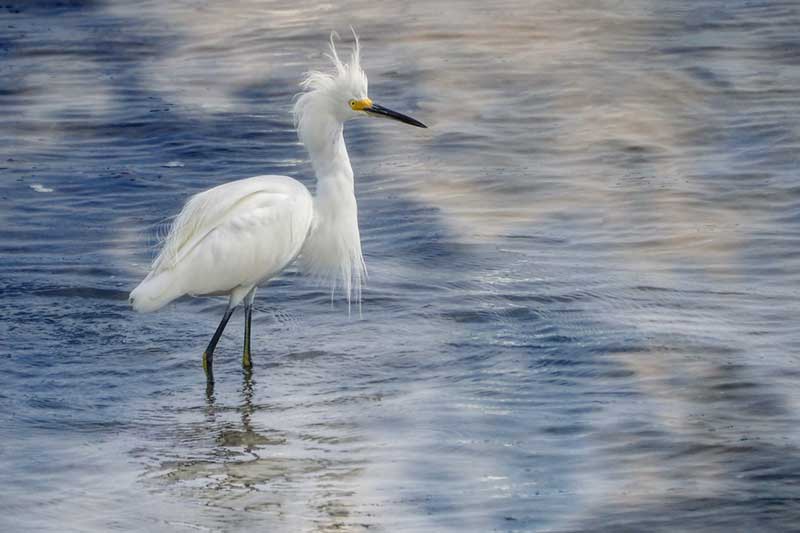There are many body types among birds, but none evokes more beauty or joy than that of the long-legged ones. Cranes especially have been revered as graceful hunters, and the long legs of all these birds serve as stilts for their primarily aquatic habitats. This is a list of 20 types of birds with long legs that are especially notable for not only their length, but the roles they play in fragile swamp ecosystems and their unique foraging techniques.
20 Unique Birds with Long Legs
1. American Bittern
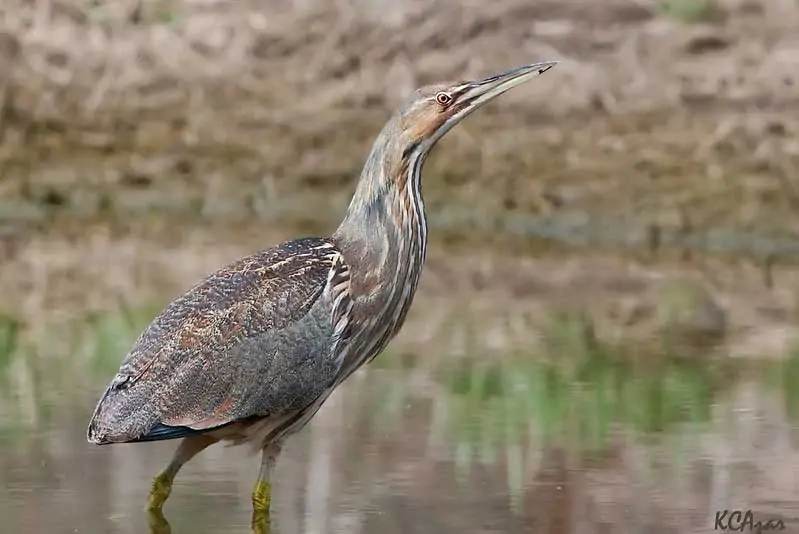
- Scientific name: Botarus lentiginosus
- Length: 36-45 inches
- Weight: 0.8-2.3 pounds
The American Bittern is a plump wading bird that’s an expert in camouflage. They have a white underbelly that’s boldly streaked with dark brown stripes that are able to easily blend in with the vegetation around them, making them especially hard to spot. Their main diet is water insects such as dragonflies and waterbugs, but they will also eat many amphibians and snakes as well.
This bird has long legs for the purposes of wading, as shown in the photo. It has an incredibly distinctive call that’s been described as similar to the sound an old wooden water pump would make. Because of this, local names for the species include “thunder-pumper” and “mire-drum” for the deep booming call.
2. Great Egret
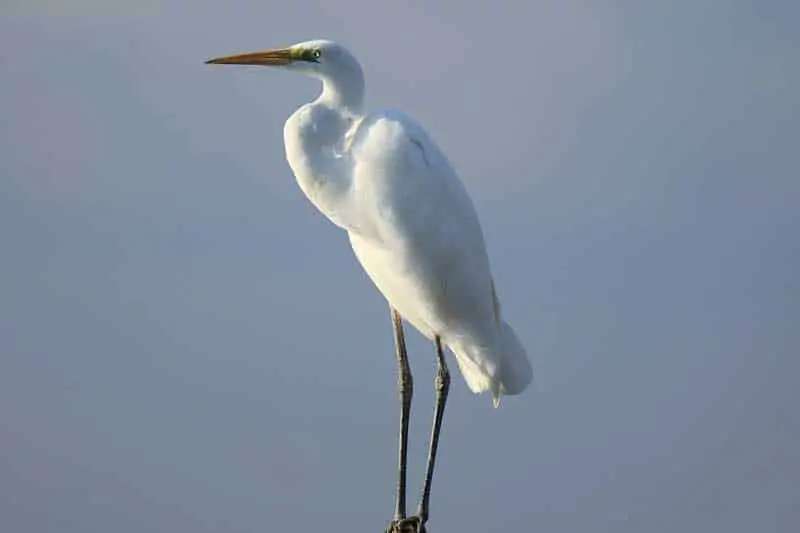
- Scientific name: Ardea alba
- Length: 2.6-3.4 feet
- Weight: 1.5-3.3 pounds
The Great Egret has bright yellow eyes and brilliant white plumage. During the mating season, they gain beautiful feather plumes that extend from the back to beyond the tail for the purposes of finding a suitable mate. They breed all throughout the United States, but prefer fresh and salt marshes, marshy ponds, and tidal flats along the Atlantic coastline.
Like most wading birds, they possess long legs ideal for standing in shallow water in search of prey. Their most distinctive characteristic is that unlike most heron species, the Great Egret flies with its neck retracted. The Great Egret also has a direct flight, meaning it flies in a straight and level path while continuously flapping their wings, and so relies entirely on their powerful and large wings for liftoff.
3. Great Blue Heron
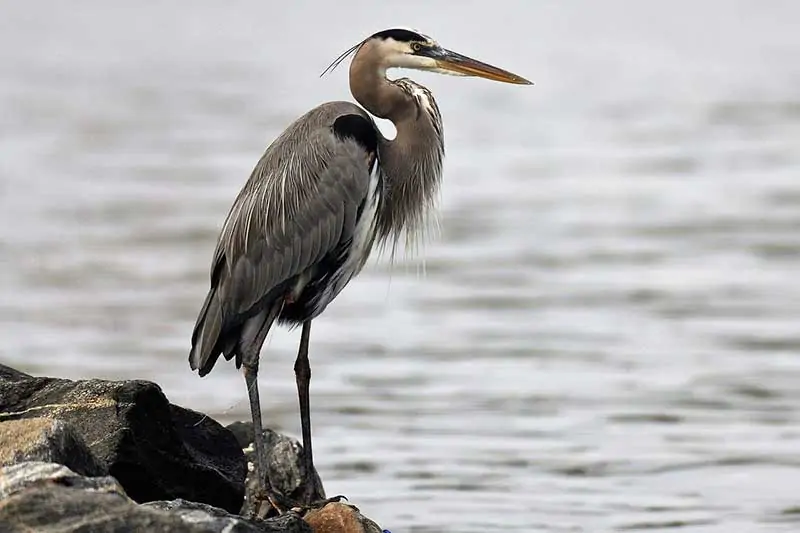
- Scientific name: Ardea herodias
- Length: 3.2-4.5 feet
- Weight: 4.6-5.5 pounds
The Great Blue Heron isn’t really blue, but more of a blue-gray on their back and a black, gray, and white striped underside. They feed mostly on small fish in their aquatic habitat, but will happily eat a variety of foods. It relies on strong wing-beats to remain in flight and follows a very steady path in the sky. Its long legs are used both for wading and for finding a higher vantage point that gives them a better view of potential prey.
Great Blue Herons are the largest herons in North America, and tend to congregate at fish hatcheries. This can occasionally cause problems for the fish farmers and has earned the Blue Heron a reputation of a pest. However, recent studies have shown that the herons tend to eat sick fish that spend more time near the surface, which actually keeps the hatcheries cleaner and a stronger ecosystem.
4. Green Heron
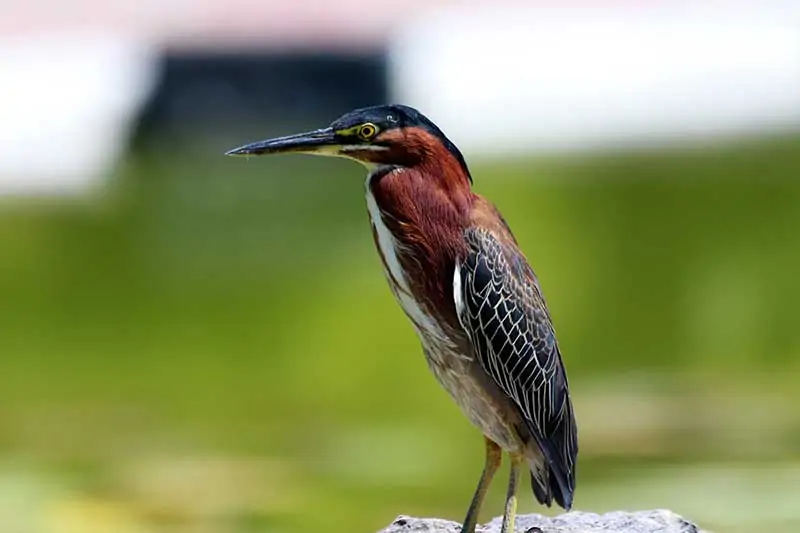
- Scientific name: Butorides virescens
- Length: 16-18 inches
- Weight: 6.2 ounces
The Green Heron breeds across most of the United States, with the exception of eastern Washington to the Dakotas. It prefers to spend winters along the west coast and in the Southern United States along rivers, oceans, lakes, and ponds. It’s an opportunistic feeder that prefers fish as their primary food, but will go after anything small enough to fit in its mouth. It technically has the shortest legs of all herons, but they’re still considerably longer than most birds and are used primarily as vantage points and wading stilts.
It’s actually one of the few tool-using birds – they’ll often drop bait onto the surface of the water and then grab the smaller fish that it attracts. They’re technically a sub-category of the Green-Backed Herons, which also includes the Striated Heron and the Galapagos Heron, but gained their own categorization for their tendency to wander following the breeding season unlike the other two.
5. Cattle Egret
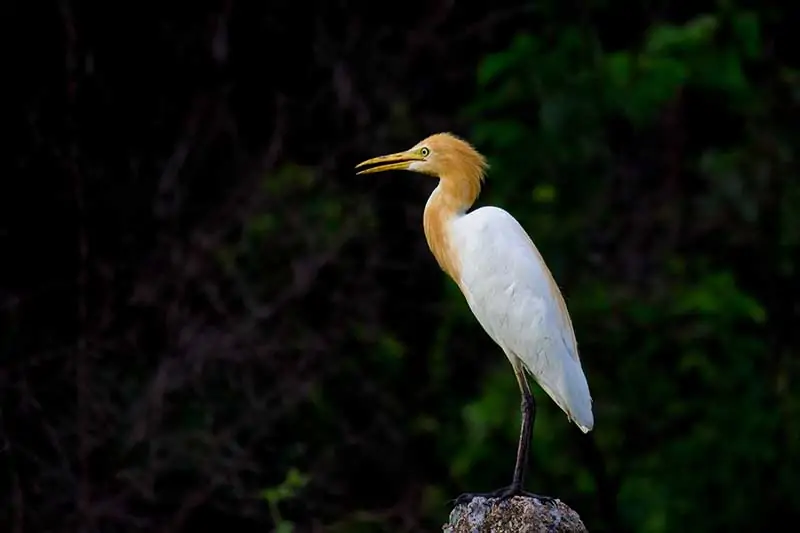
- Scientific name: Bubulcus ibis
- Length: 18-22 inches
- Weight: 9.5-18.1 ounces
The Cattle Egret is found in North America, South America, Europe, Africa, Asia, and Australia, but is believed to have originated in only central Africa and spread during the 19th century. It prefers open, grassy areas such as pastures, meadows, marshes, flood plains, and swamps. They’re also the only white egret with both a yellow bill and yellow legs. The Cattle Egret is also the best example of a bird with long legs using them to observe their environment, and also allows them to catch flying insects in a wider range of vertical motion.
It primarily feeds on water insects like water skimmers and dragonflies, but like most herons, it will also swallow many amphibians and snakes as well. They’ve taken very well to human activity, and will oftentimes congregate along the sides of airport runways. They do this in an effort to wait for the airplanes to pass and blow insects outside of the grass, and it’s estimated they gather 50% more food when near humans than not.
6. Snowy Egret
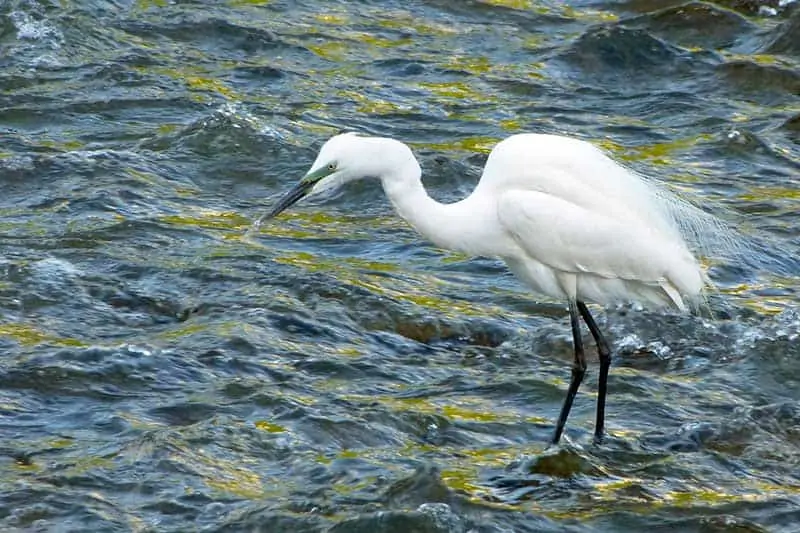
- Scientific name: Egretta thula
- Length: 2 feet
- Weight: 13 ounces
The Snowy Egret breeds locally from Oregon to New England, primarily along coastlines, and winters regularly in California, Arizona, Virginia, and Mexico. They prefer to be in marshes, swamps, and mudflats in their search for crustaceans, insects, and fish, using their long legs to keep their plumage from getting too wet and heavy. Snowy Egrets change appearance during the breeding season, with males gaining long lacy plumes down their neck and back as a mate attractor.
They were nearly hunted to extinction at the end of the 19th century, as these beautiful plumes were in great demand for decorations for women’s hats – in 1886, they were valued at twice the price of gold at the time. Now, they’ve adapted to human activity rather well and will choose urbanized nesting locations over isolated ones, as isolated locations tend to have more predators.
7. Tricolored Heron
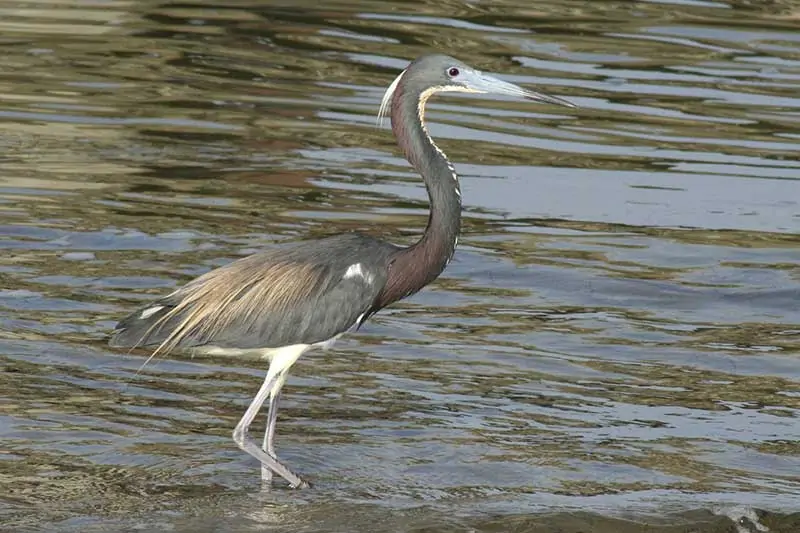
- Scientific name: Egretta tricolor
- Length: 9.8-12 inches
- Weight: 11 ounces
The Tricolored Heron breeds in southeastern New Mexico and Texas and resides along the Gulf Coast and along the Atlantic Coast all the way up to Maine. They spend winters as far south as northern South America and the West Indies. They hunt for fish on their long stilt legs in swamps, bayous, coastal ponds, salt marshes, mangrove islands, mudflats, and lagoons.
This is the only dark-colored heron that has a white belly, which helps aspiring bird watchers with easy identification. They’re one of the most abundant herons found in the Deep South and was formerly called the Louisiana Heron before it was changed to the chagrin of many Louisianan ornithologists.
8. Wood Stork
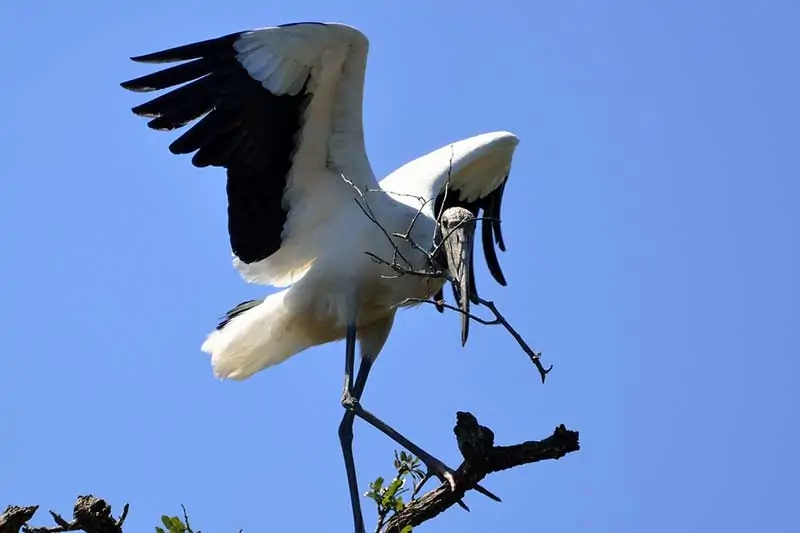
- Scientific name: Mycteria Americana
- Length: 3.3 feet
- Weight: 5.5 pounds
The Wood Stork is local to Florida and Georgia, and will rarely be seen further than Texas. However, it is still considered a wandering bird, as opposed to a migratory bird, and has been found as far as California and Massachusetts. They primarily breed in the cypress swamps, although they’ve been transitioning to mangrove swamps due to increased human pressure on their habitats.
These birds have long legs that give them a distinctive, gangly silhouette, are incredibly strong fliers, being known to fly as high as 6000 feet. They’ll also fly as far away as 50 miles in search of food. They nest above water to prevent predators from getting to their eggs, with the most common perpetrator being raccoons.
9. Whooping Crane
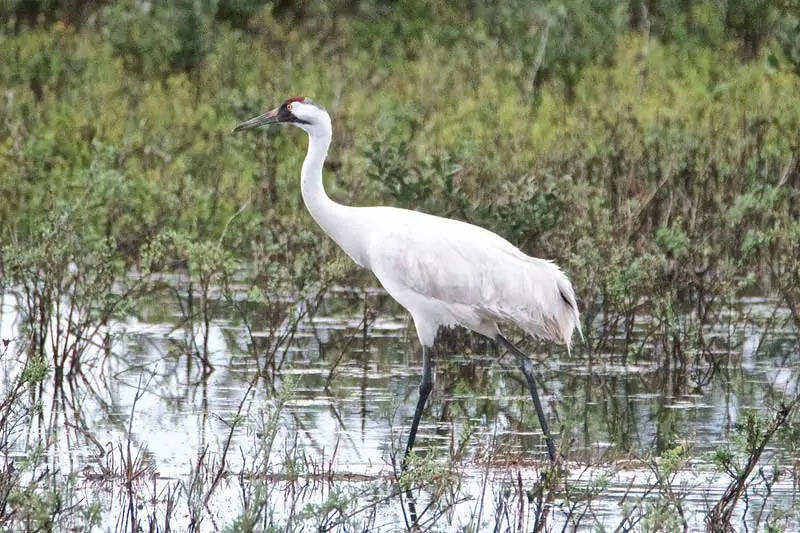
- Scientific name: Grus americana
- Length: 4.3-5.2 feet
- Weight: 9.9-19 pounds
The Whooping Crane was once widespread throughout all of North America and ranged from Utah to New England, but currently, there is only one wild population that migrates between breeding grounds in northern Canada and wintering grounds on the Texas coast. It prefers grassy plains interspersed with marshes and ponds and will eat frogs, fish, mollusks, small mammals, and crustaceans; it will essentially eat anything that gets too close to the place they’re standing on their stilt-like legs.
They’re the tallest bird in North America, with males standing nearly 5 feet tall with a wingspan of up to 7.5 feet. Unfortunately, the main cause of death for adult cranes is collisions with power lines during migration, but there’s hope for this species yet. They normally lay two eggs but only choose to raise one chick, which means it’s much easier for biologists to remove and artificially incubate them and increase their numbers bit by bit.
10. White-faced Ibis
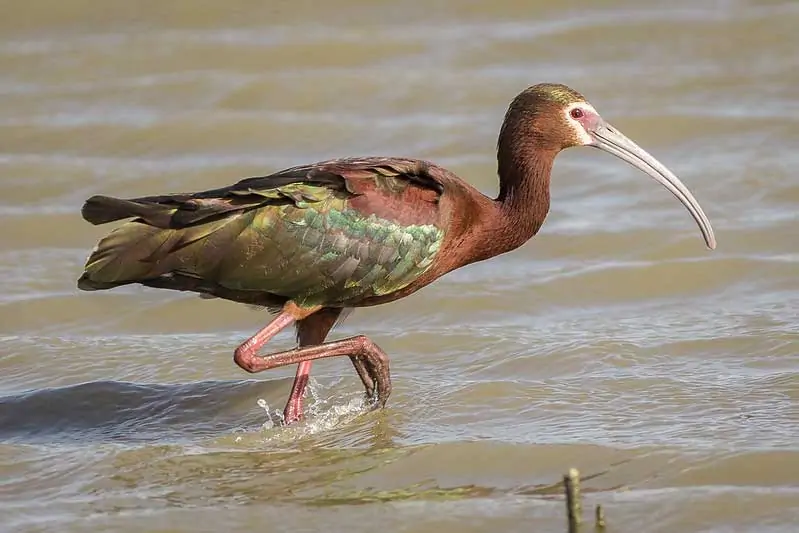
- Scientific name: Plegadis chihi
- Length: 18-22 inches
- Weight: 1.1 pounds
The White-Faced Ibis breeds from Oregon to Minnesota, and lives as far south as New Mexico and Texas. They spend their winters in southern California and Louisiana, preferring the warmer coastal marshes to the colder salt and fresh marshes inland. They eat many invertebrates as well as frogs and fish. They actually have some of the thickest legs to their body size and are incredibly sturdy birds.
It’s believed that the largest White-Faced Ibis nesting colony in the world can be found in the marshes around the Great Salt Lake in Utah. However, their populations are drastically declining throughout North America due to threats such as the draining of wetlands and the widespread use of pesticides.
11. Roseate Spoonbill
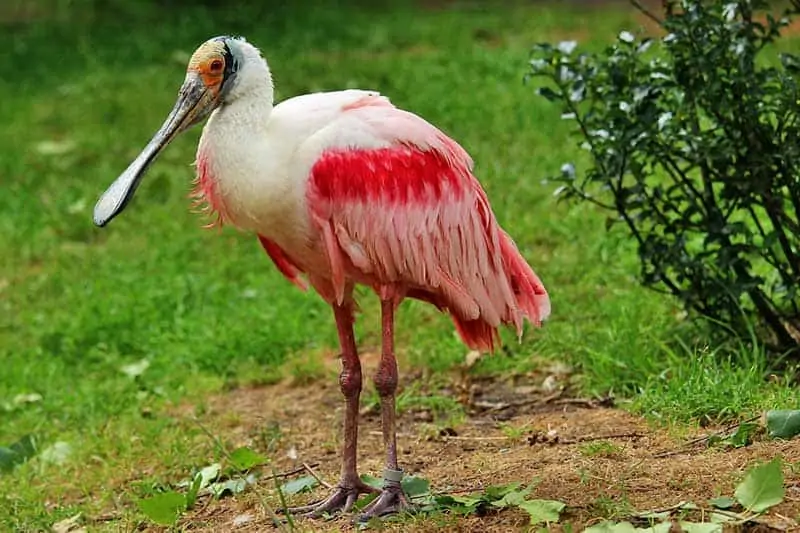
- Scientific name: Platalea ajaja
- Length: 28-32 inches
- Weight: 2.6-4 pounds
The Roseate Spoonbill is local to coastal Florida, Texas, and southwest Louisiana. They prefer to wander about in small flocks of other spoonbills, and have also been known to associate with other waders. They feed in shallow waters and use their flat bills to sift the muck by swinging their head from side to side while using their long legs to wade in the water.
This gorgeous bird is uncommon and becoming more so with each passing year. They’re especially vulnerable to degradation of their feeding and nesting habitats, which is happening more and more as a side-effect of pollution. They were virtually eliminated from the United States as a side-effect of the destruction of wader colonies by plume hunters in the 1860s, and only recently began to re-colonize Texas and Florida in the 20th century.
12. Limpkin
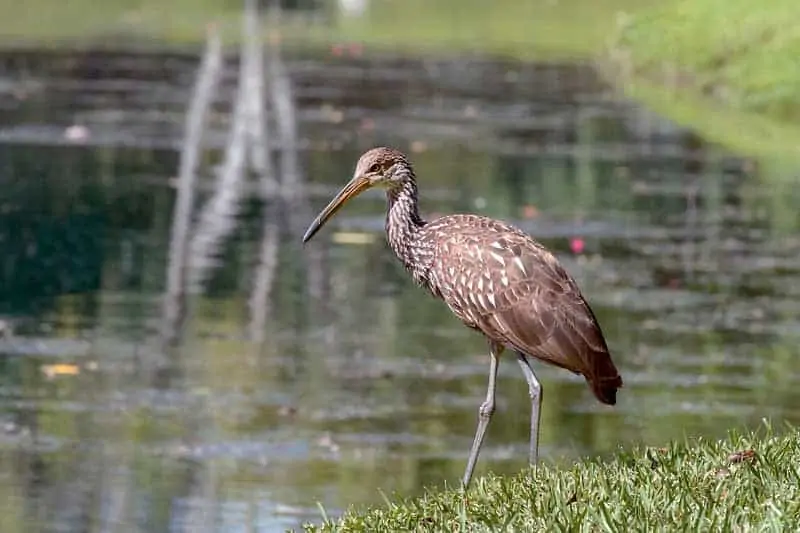
- Scientific name: Aramus guarauna
- Length: 25-29 inches
- Weight: 2-2.9 pounds
The Limpkin is a large, unique marsh bird that has a slightly decurved beak and vaguely resembles an ibis. They use their long legs to stand in the water while eating mostly freshwater snails, mussels, frogs, crustaceans, and insects in peninsular Florida and southern Mexico. They’ve also been found in South America, primarily east of the Andes and nowhere beneath the Equator, preferring wooded and brushy freshwater swamps and marshes.
It’s named for its limping-like flight, with dangling legs and jerky wing beats. It was once very common in Florida, but due to the decline of its primary food source, the Florida Apple Snail, it’s now listed as a species of special concern within the state. Collectively, a group of Limpkins is known as a “hobbling” of Limpkins.
13. American Flamingo
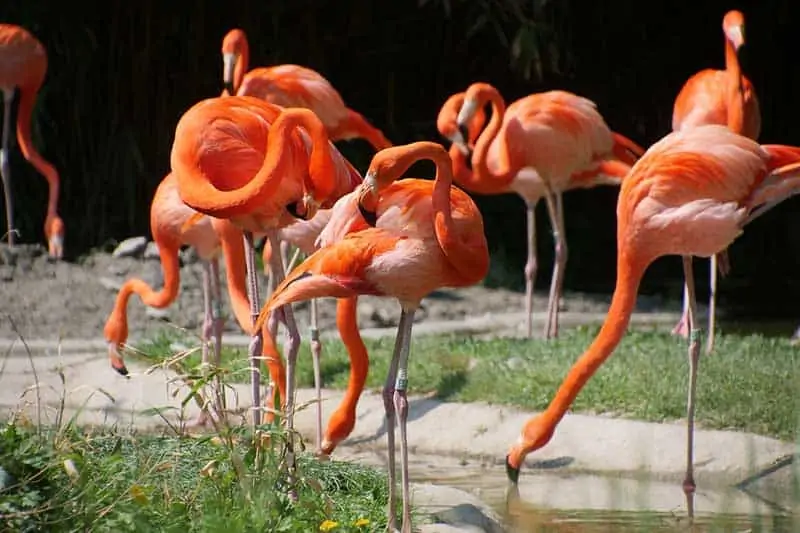
- Scientific name: Phoenicopterus rubber
- Length: 5 feet
- Weight: 4-8 pounds
Next up is an iconic bird that immediately comes to mind when people think of birds with long legs, the Flamingo. The American Flamingo is mostly distributed around the West Indies, although there have been stragglers showing up in southern Florida, Texas, and the Galapagos Islands. Their preferred habitats are saline lagoons, brackish coastal areas, inland lakes, and mudflats. They feed on algal material, bacteria diatoms, plankton, small fish, and brine fly larvae.
This is the most widespread species of the flamingo family. It gets its vibrant pink color from the food it consumes, and is considered the most distinctive aspect of the bird other than their angled black beak. At the beginning of the nesting season, they perform mass courtship displays where hundreds move together in a coordinated walk.
14. Jabiru
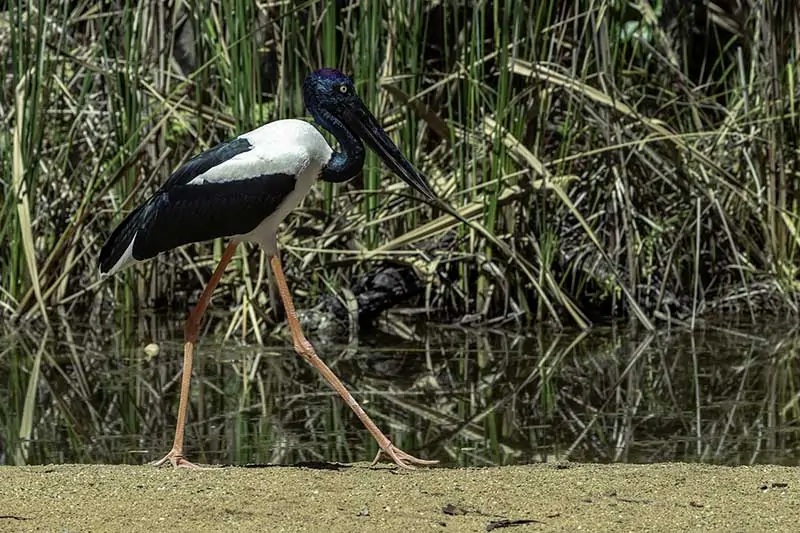
- Scientific name: Jabiru mycteria
- Length: 5 feet
- Weight: 9 pounds
Another bird that we didn’t want to leave off of a list of birds with long legs is the Jabiru. They’re one of the largest flying birds in the world and would pose an issue if they were a purely direct flier, but the Jabiru alternates between strong, slow wing beats and short glides while soaring on thermals and updrafts to stay afloat. They’re common in regions of Brazil and Paraguay, but have been spotted in bordering countries as well.
Their name comes from the local Tupi-Guarani language, meaning “swollen neck” for their strange, swollen appearance. They’re incredibly ungainly when on land, with their legs tripping them up and making their walk extremely ungraceful and jolting, but are graceful in the air and will fly with others of their species. A grouping of Jabiru is called a “filth” of storks.
15. Scarlet Ibis
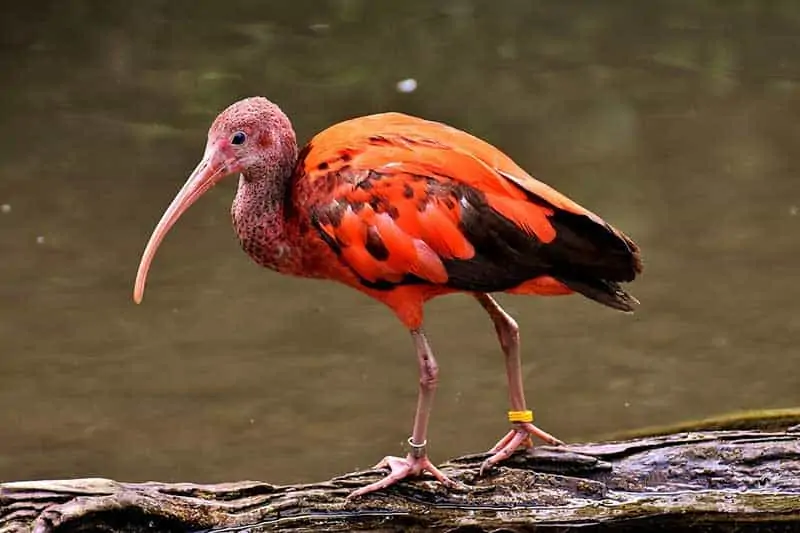
- Scientific name: Eudocimus rubber
- Length: 2.2 feet
- Weight: 1.4 pounds
The Scarlet Ibis is, as the name suggests, a beautiful orange-red ibis with black wingtips. They’re especially interesting in that they have black bills during the breeding season, but pink during all other times. They live in mangrove swamps and adjacent muddy estuaries in South America and the islands of the Caribbean. Their long legs, like most birds on this list, are used for wading in these swamps, and make them expert navigators of mangrove roots that are hidden beneath the water.
This is a hardy bird and has protected status around the world, as it was previously hunted for its brilliant red plumage, and has made a full recovery and is of least concern to the ecological community. For safety, they build their nests in trees well above the water to avoid predators, in a style that’s been called “artless” or “a loose platform of sticks”.
16. Gray Heron
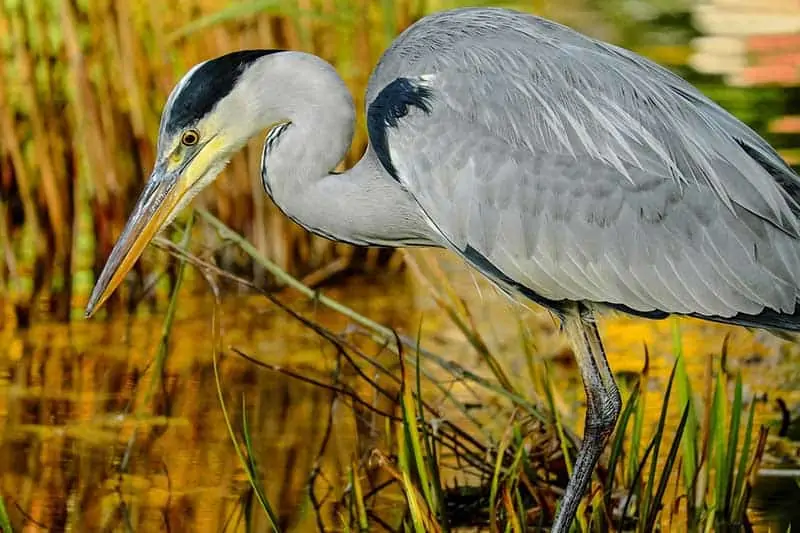
- Scientific name: Ardea cinerea jouyi
- Length: 2.8-3.3 feet
- Weight: 2.2-4.6 pounds
The Gray Heron is, as you may have guessed, a large gray wading bird. It also has yellow legs and a yellow bill that turn reddish during the breeding season. Their habitat varies throughout North America, but they prefer shallow water of all kinds so they can utilize their stilt-like legs. They feed primarily on fish, but that also varies due to season and availability.
They’ve been known to frequently re-use their nest from the previous mating season, but are not monogamous. They find a new breeding partner every season, and will often either take over what was a previously shared nest or choose to move to a new site to avoid confrontation.
17. Purple Heron
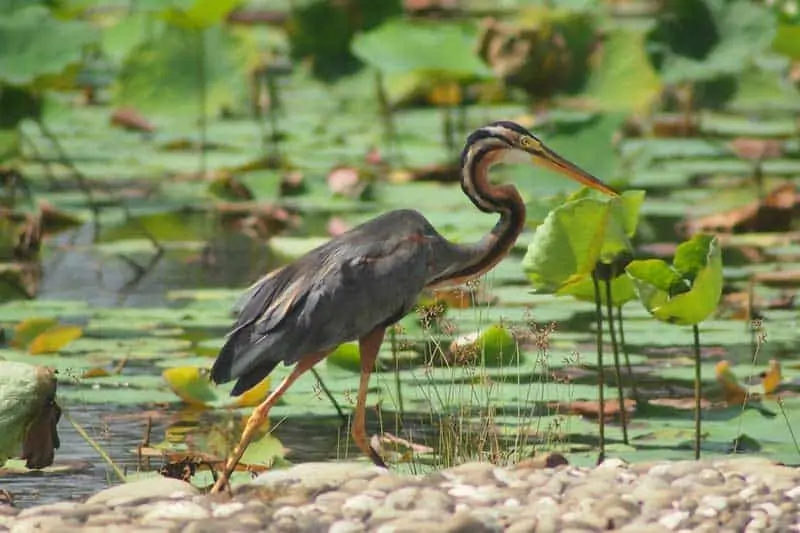
- Scientific name: Ardea purpurea
- Length: 30-45 inches
- Weight: 2.3 pounds
The Purple Heron is a bit of a misnomer, similar to the Blue Heron, as it’s more of a tawny brown and white color with a few blue-gray stripes. It has a black crown with a gorgeous long black plume and a black line across their face and under their eye, making this a distinctive bird if you get to spot them. Their long orange legs make this difficult though, as they blend in well with the long-stemmed plants that are common in their habitat.
They build their nests on a platform of sticks near the ground and close to the water in an attempt to keep their eggs safe from predators such as snakes. They’ve also been known to use “tools” of a sort, choosing to drop a feather or leaf on the surface and then lie in wait for a curious fish to come and investigate.
18. Purple Gallinule
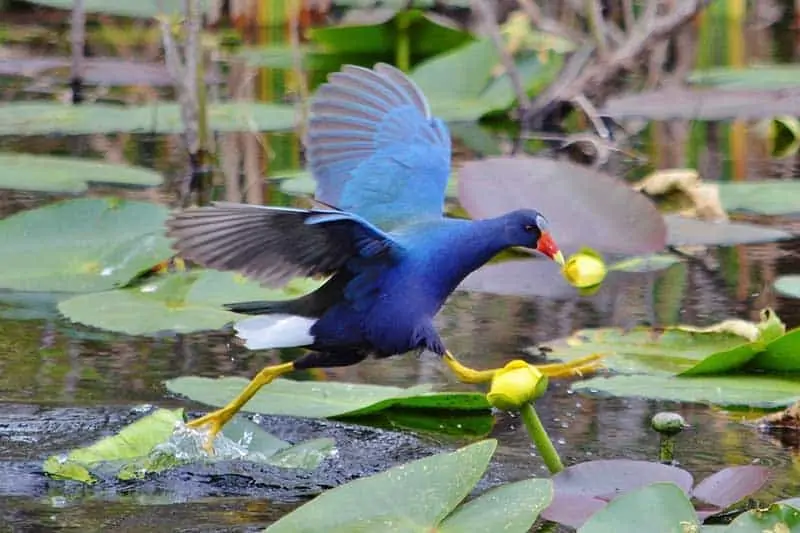
- Scientific name: Porphyrio martinicus
- Length: 10-15 inches
- Weight: 7.6-9.1 ounces
The Purple Gallinule is a medium-sized rail that’s named for its bright and distinctive plumage. It has a low, grating call that can sound similar to a chicken, but chicken noises don’t usually come from the middle of a lake. They’re found in the Florida peninsula year-round, and also breeds along the coasts of the southern states.
They migrate south for the winter and settle in the Yucatan peninsula and throughout Central America along the coasts in shallow wetlands and swamps. It forages by walking along the vegetation at the edge of the water, using its long toes and powerful legs to balance on top of lily pads and other plants. It’s also been known to forage while swimming.
19. Reddish Egret
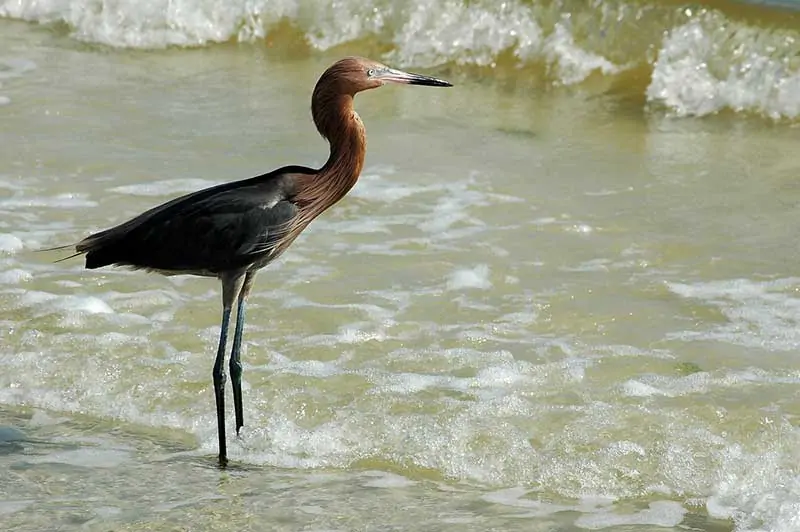
- Scientific name: Egretta rufescens
- Length: 27-32 inches
- Weight: 0.8-1.9 pounds
The Reddish Egret comes in two incredibly rare morphs – a dark and a light. The light variation is white with a bicolored bill that’s pink tipped with black, and is much scarcer than the dark morph that’s a grayish blue with reddish feathers on its head and neck. Compared to other herons, it’s considered to be plumper for its size, with a more rotund body and slightly knobbier knees that shift its center of balance much lower, making them able to hunch over the water in a “squat” much easier than other egrets.
It’s almost exclusively an inhabitant of coastal lagoons of the Gulf Coast and is probably North America’s least known heron. They hunt with a unique technique of using shade to lure fish to the surface before using quick stabbing motions to attempt to catch it. It’s considered to be the most varied and active of any North American heron in foraging techniques.
20. Sandhill Crane
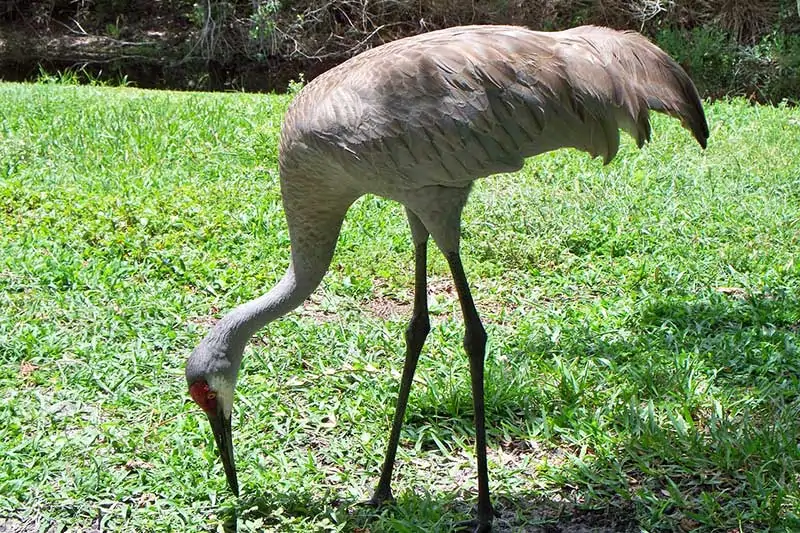
- Scientific name: Grus canadensis
- Length: 42-46 inches
- Weight: 7.1-11 pounds
The Sandhill Crane is especially beautiful and renowned for the red patch on its head, as well as a white patch on each cheek. From far away, it’s commonly mistaken for the Great Blue Heron, but unlike this heron, the Sandhill Crane flies with their neck extended rather than folded in. The sandhill crane is renowned for its long legs and is another distinctive silhouette, with many people who live in its habitat believing that if a sandhill crane flies over you, you’ll have good luck!
They have a low, rattling call that’s often compared to that of the American crow, and is the first clue to the presence of a flock of these birds. They’re opportunistic foragers who will eat more vegetation than most larger birds, but the animal portion is still incredibly important as it provides essential amino acids to their diet.
